Wortschatz
WebCorp
Language Selection | Lexicity
Language Learning Software | L-Lingo Online Application
Learn Spanish Free Online | Lessons and Tools
Learn Spanish - e Learn Spanish Language
Romance languages
The Romance languages—occasionally called the Latin languages or, less often, the Romanic or Neo-Latin languages—are a group of languages descended from Vulgar Latin. They form a branch of the Italic languages within the Indo-European language family. The five most widely spoken Romance languages by number of native speakers are Spanish (386 million), Portuguese (216 million), French (75 million), Italian (60 million), and Romanian (25 million).[2] The largest have many non-native speakers; this is especially the case for French, which is in widespread use throughout Central and West Africa, Madagascar, and the Maghreb region. The Romance languages evolved from Latin from the sixth to the ninth centuries. Ibero-Romance: Portuguese, Galician, Asturian-Leonese, Spanish, Aragonese; Occitano-Romance: Catalan, Gascon, Occitan; Gallo-Romance: Langues d'oïl (including French), Franco-Provençal; Rhaeto-Romance: Romansh, Ladin, Friulian; Sardinian; Dalmatian (extinct); Origins Name Samples History
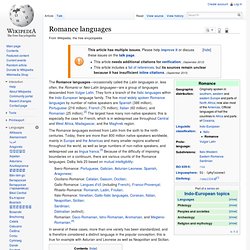
The Indo-European languages are a family of several hundred related languages and dialects. There are about 439 languages and dialects, according to the 2009 Ethnologue estimate, about half (221) belonging to the Indo-Aryan subbranch.[2] It includes most major current languages of Europe, the Iranian plateau, and the Indian Subcontinent, and was also predominant in ancient Anatolia. With written attestations appearing since the Bronze Age in the form of the Anatolian languages and Mycenaean Greek, the Indo-European family is significant to the field of historical linguistics as possessing the second-longest recorded history, after the Afro-Asiatic family. Indo-European languages are spoken by almost 3 billion native speakers,[3] the largest number by far for any recognised language family. Etymology[edit] History of Indo-European linguistics[edit] Franz Bopp, pioneer in the field of comparative linguistic studies. Gaston Coeurdoux and others made observations of the same type.
Indo-European languages
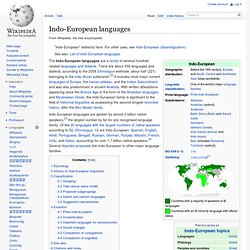
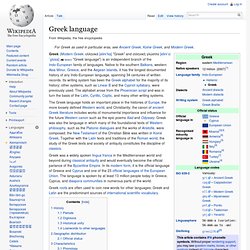
Greek language
Greek (Modern Greek: ελληνικά [eliniˈka] "Greek" and ελληνική γλώσσα [eliniˈci ˈɣlosa] ( ) "Greek language") is an independent branch of the Indo-European family of languages. Native to the southern Balkans, western Asia Minor, Greece, and the Aegean Islands, it has the longest documented history of any Indo-European language, spanning 34 centuries of written records. Its writing system has been the Greek alphabet for the majority of its history; other systems, such as Linear B and the Cypriot syllabary, were previously used. The alphabet arose from the Phoenician script and was in turn the basis of the Latin, Cyrillic, Coptic, and many other writing systems. The Greek language holds an important place in the histories of Europe, the more loosely defined Western world, and Christianity; the canon of ancient Greek literature includes works of monumental importance and influence for the future Western canon such as the epic poems Iliad and Odyssey. Idealized portrayal of Homer History[edit]
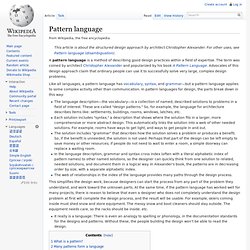 A pattern language is a method of describing good design practices within a field of expertise. The term was coined by architect Christopher Alexander and popularized by his book A Pattern Language. Advocates of this design approach claim that ordinary people can use it to successfully solve very large, complex design problems. Like all languages, a pattern language has vocabulary, syntax, and grammar—but a pattern language applies to some complex activity other than communication. The language description—the vocabulary—is a collection of named, described solutions to problems in a field of interest. This simplifies the design work, because designers can start the process from any part of the problem they understand, and work toward the unknown parts. It really is a language: There is even an analogy to spelling or phonology, in the documentation standards for the designs and patterns. What is a pattern? Many patterns form a language[edit] Design problems in a context[edit] C. Usage[edit]
A pattern language is a method of describing good design practices within a field of expertise. The term was coined by architect Christopher Alexander and popularized by his book A Pattern Language. Advocates of this design approach claim that ordinary people can use it to successfully solve very large, complex design problems. Like all languages, a pattern language has vocabulary, syntax, and grammar—but a pattern language applies to some complex activity other than communication. The language description—the vocabulary—is a collection of named, described solutions to problems in a field of interest. This simplifies the design work, because designers can start the process from any part of the problem they understand, and work toward the unknown parts. It really is a language: There is even an analogy to spelling or phonology, in the documentation standards for the designs and patterns. What is a pattern? Many patterns form a language[edit] Design problems in a context[edit] C. Usage[edit]
Pattern language
The social network for learning languages - VoxSwap
Language Exchange Community : TT4YOU
Ruby Programming Language
Lambda the Ultimate | Programming Languages Weblog
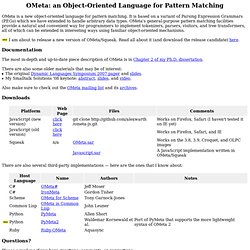
ometa/
OMeta is a new object-oriented language for pattern matching. It is based on a variant of Parsing Expression Grammars (PEGs) which we have extended to handle arbitrary data types. OMeta's general-purpose pattern matching facilities provide a natural and convenient way for programmers to implement tokenizers, parsers, visitors, and tree transformers, all of which can be extended in interesting ways using familiar object-oriented mechanisms. I am about to release a new version of OMeta/Squeak. Read all about it (and download the release candidate) here. Documentation The most in-depth and up-to-date piece description of OMeta is in Chapter 2 of my Ph.D. dissertation. There are also some older materials that may be of interest: The original Dynamic Languages Symposium 2007 paper and slides. Downloads There are also several third-party implementations — here are the ones that I know about: Questions? Please e-mail me if you have questions, comments, or suggestions.
Old Norse
 Old Norse is a North Germanic language that was spoken by inhabitants of Scandinavia and inhabitants of their overseas settlements during the Viking Age, until about 1300. The Proto-Norse language developed into Old Norse by the 8th century, and Old Norse began to develop into the modern North Germanic languages in the mid- to late 14th century, ending the language phase known as Old Norse. These dates, however, are not absolute, since written Old Norse is found well into the 15th century.[2] Old Norse was divided into three dialects: Old East Norse, Old West Norse, and Old Gutnish. Old West and East Norse formed a dialect continuum, with no clear geographical boundary between them. The 12th-century Icelandic Gray Goose Laws state that Swedes, Norwegians, Icelanders and Danes spoke the same language, dǫnsk tunga ("Danish tongue"; speakers of Old East Norse would have said dansk tunga). In some instances the term Old Norse refers specifically to Old West Norse.[3] Old West Norse dialect
Old Norse is a North Germanic language that was spoken by inhabitants of Scandinavia and inhabitants of their overseas settlements during the Viking Age, until about 1300. The Proto-Norse language developed into Old Norse by the 8th century, and Old Norse began to develop into the modern North Germanic languages in the mid- to late 14th century, ending the language phase known as Old Norse. These dates, however, are not absolute, since written Old Norse is found well into the 15th century.[2] Old Norse was divided into three dialects: Old East Norse, Old West Norse, and Old Gutnish. Old West and East Norse formed a dialect continuum, with no clear geographical boundary between them. The 12th-century Icelandic Gray Goose Laws state that Swedes, Norwegians, Icelanders and Danes spoke the same language, dǫnsk tunga ("Danish tongue"; speakers of Old East Norse would have said dansk tunga). In some instances the term Old Norse refers specifically to Old West Norse.[3] Old West Norse dialect
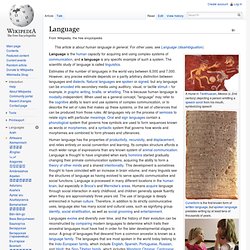 A mural in Teotihuacan, Mexico (c. 2nd century) depicting a person emitting a speech scroll from his mouth, symbolizing speech Language is the human capacity for acquiring and using complex systems of communication, and a language is any specific example of such a system. The scientific study of language is called linguistics. Languages evolve and diversify over time, and the history of their evolution can be reconstructed by comparing modern languages to determine which traits their ancestral languages must have had in order for the later developmental stages to occur. A group of languages that descend from a common ancestor is known as a language family. Definitions[edit] As an object of linguistic study, "language" has two primary meanings: an abstract concept, and a specific linguistic system, e.g. Mental faculty, organ or instinct[edit] Formal symbolic system[edit] Tool for communication[edit] The unique status of human language[edit] Origin[edit]
A mural in Teotihuacan, Mexico (c. 2nd century) depicting a person emitting a speech scroll from his mouth, symbolizing speech Language is the human capacity for acquiring and using complex systems of communication, and a language is any specific example of such a system. The scientific study of language is called linguistics. Languages evolve and diversify over time, and the history of their evolution can be reconstructed by comparing modern languages to determine which traits their ancestral languages must have had in order for the later developmental stages to occur. A group of languages that descend from a common ancestor is known as a language family. Definitions[edit] As an object of linguistic study, "language" has two primary meanings: an abstract concept, and a specific linguistic system, e.g. Mental faculty, organ or instinct[edit] Formal symbolic system[edit] Tool for communication[edit] The unique status of human language[edit] Origin[edit]
Language
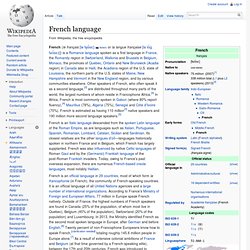
French language
French (le français [lə fʁ̥ɒ̃sɛ] ( ) or la langue française [la lɑ̃ɡ fʁɑ̃sɛz]) is a Romance language spoken as a first language in France, the Romandy region in Switzerland, Wallonia and Brussels in Belgium, Monaco, the provinces of Quebec, Ontario and New Brunswick (Acadia region) in Canada also in Haiti, the Acadiana region of the U.S. state of Louisiana, the northern parts of the U.S. states of Maine, New Hampshire and Vermont in the New England region, and by various communities elsewhere. Other speakers of French, who often speak it as a second language,[3] are distributed throughout many parts of the world, the largest numbers of whom reside in Francophone Africa.[4] In Africa, French is most commonly spoken in Gabon (where 80% report fluency),[4] Mauritius (78%), Algeria (75%), Senegal and Côte d'Ivoire (70%). French is estimated as having 110 million[3] native speakers and 190 million more second language speakers.[5] Geographic distribution[edit] Europe[edit] Belgium[edit]
BASIC
BASIC (an acronym for Beginner's All-purpose Symbolic Instruction Code) is a family of general-purpose, high-level programming languages whose design philosophy emphasizes ease of use. In 1964, John G. Kemeny and Thomas E. Kurtz designed the original BASIC language at Dartmouth College in New Hampshire. They wanted to enable students in fields other than science and mathematics to use computers. At the time, nearly all use of computers required writing custom software, which was something only scientists and mathematicians tended to learn how to use. Versions of BASIC became widespread on microcomputers in the mid-1970s and 1980s. History[edit] Before the mid-1960s, computers were extremely expensive mainframe machines, usually requiring a dedicated computer room and air-conditioning, used by large organizations for scientific and commercial tasks. Origin[edit] The designers of the language decided to make the compiler available free of charge so that the language would become widespread.
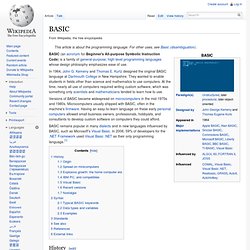

Borland C++
Libraries[edit] Object Windows Library (OWL): A set of C++ classes to make it easier to develop professional graphical Windows applications. Borland Graphics Interface: A library of functions for doing simple, presentation-style 2D graphics. Add-ons[edit] Borland Power Pack for DOS: Used to create 16- and 32-bit protected mode DOS applications, which can access a limited scope of the Windows API and call functions in any Windows DLL. Version History[edit] Borland C++ 2.0 - (1991, MS-DOS)Borland C++ 3.0 - (1991) New compiler support to build Microsoft Windows applications.Borland C++ 3.1 - (1992) Introduction of Windows-based IDE and application frameworks (OWL 1.0, Turbovision 1.0)Borland C++ 4.0 - (1993, Windows 3.x) MS-DOS IDE supported no longer, included OWL 2.0.Borland C++ 1.0 - (1992, OS/2)Borland C++ 1.5 - (? Evolution of Borland C++[edit] Borland C++ evolved in a number of steps: Turbo C++ → Borland C++ → Borland C++Builder → CodeGear C++Builder → Embarcadero C++Builder See also[edit]
Computing Languages List - Profile :: CareerCtr
HyperNews Home Using HyperNews (Instructions) HYPERNEWS COMPUTER LANGUAGE LIST v 1.4 These snippets have been culled from existing programming language sources, the language designer's web pages, books, articles and language critiques. They are by no means meant to be the definitive language definitions, but rather quick and painless definitions and links to available language web sites and newsgroups. Special Thanks to Dr John Stockton. Corrections, omissions, and any feedback is encouraged and appreciated. Please support Open Source. Eric Lebherz June 16,2005 EricLebherz@yahoo.com Part 1 - Definitions of Computer Language Families Part 2 - Definitions of Computer Languages Part 3 - Links to Essential Computer Language Web Sites Part 4 - Links to Computer Language Software Part 5 - Sammet's 26 Most Significant Programming Languages, By Year Part 6 - Bibliography Part 7 - Abbreviations APPLICATIVE LANGUAGES- operates by application of functions to values. QUERY LANGUAGES- an interface to a database.
LyrnLang
Language Exchange - Global Language Exchange Initiative
Mathematics
Skoool.co.uk A fantastic free resource to support maths and science at Key Stages 3 and 4. There are wonderful interactive activities and study notes. Calculation Balance An excellent site for addition, subtraction, multiplication and division practice. Christmas Maths A useful resource for Christmas time which includes a range of great number activities which are aimed at Year 1 pupils (5 - 6 years). Ladybird Spots Three different counting, matching and ordering maths games based on the numbers 1 to 10 for early years children. Multiplication Try this good game for practising your times tables. Loop Cards Fantastic for improving your mental maths. Teddy Numbers The Teddy Numbers game can help you to learn numbers to 15. Underwater Counting Can you find the treasure? Primary Worksheets A selection of good quality maths worksheets. S-Cool! An excellent revision site which covers the main principles on most syllabuses.
dotSUB.com ~ Any film in any language.
In 1969, in response to a request to participate in an exhibition at the Architectural League in New York, Giorno (a poet, artist, and activist) devised this work. Among the first telephonic artworks, Dial-a-Poem allowed the public to access an archive of recordings of work by contemporary poets; by calling a local telephone number, participants could hear a well-known poet like John Ashbery or Allen Ginsberg recite a short poem selected at random by a primitive answering machine system. A year later, Giorno created an expanded version of the work for Information, an exhibition of Conceptual art at The Museum of Modern Art. Vito Acconci “Hello.” 2:05“There, Then.” 1:52“Pronouncing.” 1:25“Hair, Forehead.” 2:06“Small.” 2:00 Kathy Acker “I Was Walking Down the Street.” 2:30 Helen Adam “Cheerless Junkie Song.” 2:45 Miguel Algarin “Setanta y Cinco Abriles.” 1:43 Laurie Anderson “Born Never Asked.” 4:30“Closed Circuits.” 7:26“Dr. Penny Arcade “Two Poems.” John Ashbery Amiri Baraka Bill Berkson David Byrne
MoMA | Ecstatic Alphabets/Heaps of Language | Dial-a-Poem
Communicative Language Teaching†‎
Details Hits: 8,192 Communicative Language Teaching (or CLT) is a popular approach to language teaching which emphasizes using language in the same way that it's used in real life. In other words, you put your students in language situations which are as close to real life as possible. Origins of CLT Before the spread of communicative teaching, teachers tended to use traditional grammar translation or audio-lingual methods of teaching. In other words, they would give the class grammar rules and paradigms, drill the class in set phrases, have them recite verb conjugations and learn word lists by heart. Critics of these methods felt that students were not learning useful, functional English and once they were out of the classroom they were not fully prepared to deal in real English. Communicative Language Teaching Overview With CLT, you give your students language they need to deal with real situations. Typical CLT Classroom Activities Typical Intermediate Activity Useful Links
The history of English is a complex and dynamic history. It is often, albeit perhaps too neatly, divided into four periods: Old English, Middle English, Early-Modern English, and Late-Modern English. English is classified genetically as a Low West Germanic language of the Indo-European family of languages. Currently, nearly two billion people around the globe understand it. It is the language of aviation, science, computing, international trade, and diplomacy. It holds a crucial place in the cultural, political, and economic affairs in countries all over the world. Old English (500-1100AD) It is nearly impossible to identify the birth of a language, but in the case of English, it is safe to say that it did not exist before the West Germanic tribes settled Britain. Before the Germanic tribes arrived, the Celts were the original inhabitants of Britain. The Norman Conquest and Middle English (1100-1500) Early Modern English (1500-1800) Late-Modern English (1800-Present) Global English
Great Melting Pot of Language: History of the English Language
History of the English Language | Site for Language Management in Canada (SLMC) – Official Languages and Bilingualism Institute (OLBI)
Language families
Enduring voices: documenting the planet's endangered languages
Vanishing Languages
Lists of endangered languages




 Greek language
Greek (Modern Greek: ελληνικά [eliniˈka] "Greek" and ελληνική γλώσσα [eliniˈci ˈɣlosa] ( ) "Greek language") is an independent branch of the Indo-European family of languages. Native to the southern Balkans, western Asia Minor, Greece, and the Aegean Islands, it has the longest documented history of any Indo-European language, spanning 34 centuries of written records. Its writing system has been the Greek alphabet for the majority of its history; other systems, such as Linear B and the Cypriot syllabary, were previously used. The alphabet arose from the Phoenician script and was in turn the basis of the Latin, Cyrillic, Coptic, and many other writing systems. The Greek language holds an important place in the histories of Europe, the more loosely defined Western world, and Christianity; the canon of ancient Greek literature includes works of monumental importance and influence for the future Western canon such as the epic poems Iliad and Odyssey. Idealized portrayal of Homer History[edit]
Greek language
Greek (Modern Greek: ελληνικά [eliniˈka] "Greek" and ελληνική γλώσσα [eliniˈci ˈɣlosa] ( ) "Greek language") is an independent branch of the Indo-European family of languages. Native to the southern Balkans, western Asia Minor, Greece, and the Aegean Islands, it has the longest documented history of any Indo-European language, spanning 34 centuries of written records. Its writing system has been the Greek alphabet for the majority of its history; other systems, such as Linear B and the Cypriot syllabary, were previously used. The alphabet arose from the Phoenician script and was in turn the basis of the Latin, Cyrillic, Coptic, and many other writing systems. The Greek language holds an important place in the histories of Europe, the more loosely defined Western world, and Christianity; the canon of ancient Greek literature includes works of monumental importance and influence for the future Western canon such as the epic poems Iliad and Odyssey. Idealized portrayal of Homer History[edit]
 A pattern language is a method of describing good design practices within a field of expertise. The term was coined by architect Christopher Alexander and popularized by his book A Pattern Language. Advocates of this design approach claim that ordinary people can use it to successfully solve very large, complex design problems. Like all languages, a pattern language has vocabulary, syntax, and grammar—but a pattern language applies to some complex activity other than communication. The language description—the vocabulary—is a collection of named, described solutions to problems in a field of interest. This simplifies the design work, because designers can start the process from any part of the problem they understand, and work toward the unknown parts. It really is a language: There is even an analogy to spelling or phonology, in the documentation standards for the designs and patterns. What is a pattern? Many patterns form a language[edit] Design problems in a context[edit] C. Usage[edit]
Pattern language
A pattern language is a method of describing good design practices within a field of expertise. The term was coined by architect Christopher Alexander and popularized by his book A Pattern Language. Advocates of this design approach claim that ordinary people can use it to successfully solve very large, complex design problems. Like all languages, a pattern language has vocabulary, syntax, and grammar—but a pattern language applies to some complex activity other than communication. The language description—the vocabulary—is a collection of named, described solutions to problems in a field of interest. This simplifies the design work, because designers can start the process from any part of the problem they understand, and work toward the unknown parts. It really is a language: There is even an analogy to spelling or phonology, in the documentation standards for the designs and patterns. What is a pattern? Many patterns form a language[edit] Design problems in a context[edit] C. Usage[edit]
Pattern language
 ometa/
OMeta is a new object-oriented language for pattern matching. It is based on a variant of Parsing Expression Grammars (PEGs) which we have extended to handle arbitrary data types. OMeta's general-purpose pattern matching facilities provide a natural and convenient way for programmers to implement tokenizers, parsers, visitors, and tree transformers, all of which can be extended in interesting ways using familiar object-oriented mechanisms. I am about to release a new version of OMeta/Squeak. Read all about it (and download the release candidate) here. Documentation The most in-depth and up-to-date piece description of OMeta is in Chapter 2 of my Ph.D. dissertation. There are also some older materials that may be of interest: The original Dynamic Languages Symposium 2007 paper and slides. Downloads There are also several third-party implementations — here are the ones that I know about: Questions? Please e-mail me if you have questions, comments, or suggestions.
ometa/
OMeta is a new object-oriented language for pattern matching. It is based on a variant of Parsing Expression Grammars (PEGs) which we have extended to handle arbitrary data types. OMeta's general-purpose pattern matching facilities provide a natural and convenient way for programmers to implement tokenizers, parsers, visitors, and tree transformers, all of which can be extended in interesting ways using familiar object-oriented mechanisms. I am about to release a new version of OMeta/Squeak. Read all about it (and download the release candidate) here. Documentation The most in-depth and up-to-date piece description of OMeta is in Chapter 2 of my Ph.D. dissertation. There are also some older materials that may be of interest: The original Dynamic Languages Symposium 2007 paper and slides. Downloads There are also several third-party implementations — here are the ones that I know about: Questions? Please e-mail me if you have questions, comments, or suggestions.
 Old Norse is a North Germanic language that was spoken by inhabitants of Scandinavia and inhabitants of their overseas settlements during the Viking Age, until about 1300. The Proto-Norse language developed into Old Norse by the 8th century, and Old Norse began to develop into the modern North Germanic languages in the mid- to late 14th century, ending the language phase known as Old Norse. These dates, however, are not absolute, since written Old Norse is found well into the 15th century.[2] Old Norse was divided into three dialects: Old East Norse, Old West Norse, and Old Gutnish. Old West and East Norse formed a dialect continuum, with no clear geographical boundary between them. The 12th-century Icelandic Gray Goose Laws state that Swedes, Norwegians, Icelanders and Danes spoke the same language, dǫnsk tunga ("Danish tongue"; speakers of Old East Norse would have said dansk tunga). In some instances the term Old Norse refers specifically to Old West Norse.[3] Old West Norse dialect
Old Norse is a North Germanic language that was spoken by inhabitants of Scandinavia and inhabitants of their overseas settlements during the Viking Age, until about 1300. The Proto-Norse language developed into Old Norse by the 8th century, and Old Norse began to develop into the modern North Germanic languages in the mid- to late 14th century, ending the language phase known as Old Norse. These dates, however, are not absolute, since written Old Norse is found well into the 15th century.[2] Old Norse was divided into three dialects: Old East Norse, Old West Norse, and Old Gutnish. Old West and East Norse formed a dialect continuum, with no clear geographical boundary between them. The 12th-century Icelandic Gray Goose Laws state that Swedes, Norwegians, Icelanders and Danes spoke the same language, dǫnsk tunga ("Danish tongue"; speakers of Old East Norse would have said dansk tunga). In some instances the term Old Norse refers specifically to Old West Norse.[3] Old West Norse dialect
 A mural in Teotihuacan, Mexico (c. 2nd century) depicting a person emitting a speech scroll from his mouth, symbolizing speech Language is the human capacity for acquiring and using complex systems of communication, and a language is any specific example of such a system. The scientific study of language is called linguistics. Languages evolve and diversify over time, and the history of their evolution can be reconstructed by comparing modern languages to determine which traits their ancestral languages must have had in order for the later developmental stages to occur. A group of languages that descend from a common ancestor is known as a language family. Definitions[edit] As an object of linguistic study, "language" has two primary meanings: an abstract concept, and a specific linguistic system, e.g. Mental faculty, organ or instinct[edit] Formal symbolic system[edit] Tool for communication[edit] The unique status of human language[edit] Origin[edit]
Language
A mural in Teotihuacan, Mexico (c. 2nd century) depicting a person emitting a speech scroll from his mouth, symbolizing speech Language is the human capacity for acquiring and using complex systems of communication, and a language is any specific example of such a system. The scientific study of language is called linguistics. Languages evolve and diversify over time, and the history of their evolution can be reconstructed by comparing modern languages to determine which traits their ancestral languages must have had in order for the later developmental stages to occur. A group of languages that descend from a common ancestor is known as a language family. Definitions[edit] As an object of linguistic study, "language" has two primary meanings: an abstract concept, and a specific linguistic system, e.g. Mental faculty, organ or instinct[edit] Formal symbolic system[edit] Tool for communication[edit] The unique status of human language[edit] Origin[edit]
Language
 French language
French (le français [lə fʁ̥ɒ̃sɛ] ( ) or la langue française [la lɑ̃ɡ fʁɑ̃sɛz]) is a Romance language spoken as a first language in France, the Romandy region in Switzerland, Wallonia and Brussels in Belgium, Monaco, the provinces of Quebec, Ontario and New Brunswick (Acadia region) in Canada also in Haiti, the Acadiana region of the U.S. state of Louisiana, the northern parts of the U.S. states of Maine, New Hampshire and Vermont in the New England region, and by various communities elsewhere. Other speakers of French, who often speak it as a second language,[3] are distributed throughout many parts of the world, the largest numbers of whom reside in Francophone Africa.[4] In Africa, French is most commonly spoken in Gabon (where 80% report fluency),[4] Mauritius (78%), Algeria (75%), Senegal and Côte d'Ivoire (70%). French is estimated as having 110 million[3] native speakers and 190 million more second language speakers.[5] Geographic distribution[edit] Europe[edit] Belgium[edit]
French language
French (le français [lə fʁ̥ɒ̃sɛ] ( ) or la langue française [la lɑ̃ɡ fʁɑ̃sɛz]) is a Romance language spoken as a first language in France, the Romandy region in Switzerland, Wallonia and Brussels in Belgium, Monaco, the provinces of Quebec, Ontario and New Brunswick (Acadia region) in Canada also in Haiti, the Acadiana region of the U.S. state of Louisiana, the northern parts of the U.S. states of Maine, New Hampshire and Vermont in the New England region, and by various communities elsewhere. Other speakers of French, who often speak it as a second language,[3] are distributed throughout many parts of the world, the largest numbers of whom reside in Francophone Africa.[4] In Africa, French is most commonly spoken in Gabon (where 80% report fluency),[4] Mauritius (78%), Algeria (75%), Senegal and Côte d'Ivoire (70%). French is estimated as having 110 million[3] native speakers and 190 million more second language speakers.[5] Geographic distribution[edit] Europe[edit] Belgium[edit]

 Borland C++
Libraries[edit] Object Windows Library (OWL): A set of C++ classes to make it easier to develop professional graphical Windows applications. Borland Graphics Interface: A library of functions for doing simple, presentation-style 2D graphics. Add-ons[edit] Borland Power Pack for DOS: Used to create 16- and 32-bit protected mode DOS applications, which can access a limited scope of the Windows API and call functions in any Windows DLL. Version History[edit] Borland C++ 2.0 - (1991, MS-DOS)Borland C++ 3.0 - (1991) New compiler support to build Microsoft Windows applications.Borland C++ 3.1 - (1992) Introduction of Windows-based IDE and application frameworks (OWL 1.0, Turbovision 1.0)Borland C++ 4.0 - (1993, Windows 3.x) MS-DOS IDE supported no longer, included OWL 2.0.Borland C++ 1.0 - (1992, OS/2)Borland C++ 1.5 - (? Evolution of Borland C++[edit] Borland C++ evolved in a number of steps: Turbo C++ → Borland C++ → Borland C++Builder → CodeGear C++Builder → Embarcadero C++Builder See also[edit]
Borland C++
Libraries[edit] Object Windows Library (OWL): A set of C++ classes to make it easier to develop professional graphical Windows applications. Borland Graphics Interface: A library of functions for doing simple, presentation-style 2D graphics. Add-ons[edit] Borland Power Pack for DOS: Used to create 16- and 32-bit protected mode DOS applications, which can access a limited scope of the Windows API and call functions in any Windows DLL. Version History[edit] Borland C++ 2.0 - (1991, MS-DOS)Borland C++ 3.0 - (1991) New compiler support to build Microsoft Windows applications.Borland C++ 3.1 - (1992) Introduction of Windows-based IDE and application frameworks (OWL 1.0, Turbovision 1.0)Borland C++ 4.0 - (1993, Windows 3.x) MS-DOS IDE supported no longer, included OWL 2.0.Borland C++ 1.0 - (1992, OS/2)Borland C++ 1.5 - (? Evolution of Borland C++[edit] Borland C++ evolved in a number of steps: Turbo C++ → Borland C++ → Borland C++Builder → CodeGear C++Builder → Embarcadero C++Builder See also[edit]